- Home
- Tad Williams
Shadowmarch s-1
Shadowmarch s-1 Read online
Shadowmarch
( Shadowmarch - 1 )
Tad Williams
At the uppermost edge of the northern kingdoms, towers shrouded in mist, lies Southmarch Castle. For hundreds of years it has remained hidden from the affairs of empire. Now its isolation can protect it no more. Southmarch is under siege; from both its neighbours, without, and the more insidious enemies who would destroy it from within.
Even further to the north, within the ancient walls of Qul-na-Qar, in a land of silence and gloom, the Twilight People gather to hear Ynnir, the blind king, pronounce the dark fate of human kind. In the south, the Autarch, the god-king who has already conquered an entire continent, now looks to extend his domain once more.
It is upon Southmarch that the armies advance, and to its people that darkness will speed.
Tad Williams
SHADOWMARCH
This book is dedicated to my children, Connor Williams and Devon Beale, who as I write this are still small but extremely powerful. They amaze me every day.
Someday, when they are grown and their mother and I have ambled on to the Fields Beyond, I hope the two of them will be warmed by the knowledge of how fiercely we loved them, and a tiny bit embarrassed by how wickedly they took advantage of it, charming, funny little buggers that they are.
Aknowlegments
No book is written without help, and few authors need as much help as I do, so… on with the parade of gratitude!
Many thanks, as always, to my fabulous wife, Deborah Beale, for her unfailing support and brilliant help and discerning reader’s eye, and to my most excellent agent Matt Bialer, for having my back when the quibbles are flying.
Thanks also to our talented assistant, Dena Chavez, who keeps Deborah and I as close to sane as we are ever likely to get, in part by immense organizational skill, in part by preventing my beloved children from helping me too much when I really need to finish something.
My overseas editors, Tim Holman in the UK and Dr. Ulrike Killer in Germany, have been big supporters of my work and give me a great deal of confidence with all the projects I undertake. They have my overwhelming gratitude, too.
And of course all my friends at DAW Books—who also (conveniently!) happen to be my American publishers—including Debra Euler, Marsha Jones, Peter Stampfel, Betsy Wollheim, and Sheila Gilbert, cannot escape much vigorous thank-ification. Betsy and Sheila have been my editors and partners-in-crime since I started on this wild book-writing endeavor twenty years ago, and the more years that pass, the more I come to realize what a great gift that has been and how lucky I am. Thanks, guys. We’ve had fun, huh?
Last but not least, I must also mention that this particular book owes a huge debt of gratitude and inspiration to all the mad, wonderful folk on the Shadowmarch.com bulletin board, a repository of wisdom, support, silliness, and recipes for rhubarb like no other. Thanks for Shadowmarch (the online project) are especially due to Josh Milligan and the incomparable Matt Dusek, the latter still helming the site as Tech Wizard in Residence. I hope many of you new readers will come and join us—I spend a lot of time kibitzing on the board there, and I’d enjoying meeting you.
Authorʼs Note
For those who wish to feel securely grounded in the Who, What, and Where of things, there are several maps and, at the end of the book, indexes of characters and places and other important materials.
The maps have been complied from an exhaustive array of traveler’s tales, nearly illegible old documents, transcripts of oracular utterances, and the murmunngs of dying hermits, not to mention the contents of an ancient box of land-office records discovered at a Syannese flea market. A similarly arcane and wearying process was responsible for the creation of the indexes. Use them well, remembering that many have died, or at least seriously damaged their vision and scholarly reputations, to make these aids available to you, the reader.
A Brief History of Eion
With special Attention paid to Rise of the March Kingdoms of the North. Summarized by Finn Teodoros, scholar, from Clemon’s. The History of Our Continent of Eion and its Nations, at the request of his lordship Avin Brone, Count of Landsend, Lord Constable of Southmarch Presented this Thirteenthth day of Enneamene, in the year thirteen hundred and sixteen of the Holy Trigon.
For almost a thousand years before our Trigonate Era, history was written only in the ancient kingdoms of Xand, the southern continent that was the world’s first seat of civilization. The Xandians knew little about their northern neighbor, our continent of Eion, because most of its interior was hidden by impassable mountains and dense forests.The southerners traded only with a few pale-skinned savages who dwelled along the coasts, and knew little or nothing about the mysterious Twilight People, called “Qar” by the scholarly, who lived in many places across Eion, but were and are most numerous in the far north of our continent.
As generations passed and Xandian trade with Eion increased, Hierosol, the chief of the new trading port towns on the Eionian coast, grew as well, until it had become by far the most populous city of the northern lands. By about two centuries before the advent of the blessed Trigon, it had grown to rival in size and sophistication many of the decadent capitals of the southern continent.
Hierosol in its early years was a city of many gods and many competing priesthoods, and matters of doctrinal dispute and godly rivalry were often settled by slander and arson and bloody riots in the streets. At last, the followers of three of the most powerful deities—Perin, lord of the sky, Erivor of the waters, and Kernios, master of the black earth—made a compact. This trigon, the coalition of the three gods and their followers, quickly lifted itself above all the other priesthoods and their temples in power. Its leader took the name Trigonarch, and he and his successors became the mightiest religious figures in all of Eion.
With rich trade flooding through its ports, its army and navy growing in power, and religious authority now consolidated in the hands of the Trigonate, Hierosol became not just the dominant power in Eion, but eventually, as the empires of the southern continent Xand spiraled down into decadence, of all the known world. Hierosoline supremacy lasted for almost six hundred years before the empire collapsed at last of its own weight, falling before waves of raiders from the Kracian peninsula and the southern continent.
Younger kingdoms in Eion’s heartland rose from Hierosol’s imperial ashes. Syan outstripped the others, and in the ninth century seized the Trigonate itself, moving the Trigonarchy and all its great church from Hierosol to Tessis, where they still remain. Syan became the seat of fashion and learning for all Eion, and is still by most measures the leading power of our continent today, but its neighbors have long since shrugged off the mantle of the Syannese Empire.
* * *
Since a time before history, the men of Eion have shared their lands with the strange, pagan Qar, who were known variously as the Twilight People, the Quiet People, or most often “the fairy folk.” Although stories tell of a vast Qar settlement in the far north of Eion, a dark and ancient city of dire report, the Qar at first lived in many places throughout the land, although never in such concentrations as men, and mostly in rural, untraveled areas. As men spread across Eion, many of the Qar retreated to the hills and mountains and deep forests, although in some places they remained, and even lived in peace with men. There was little trust, though, and for most of the first millennium after the Trigon the unspoken truce between the two peoples was largely due to the small numbers of the Twilight folk and their isolation from men.
As the year 1000 approached, the Great Death came, a terrible plague that appeared first in the southern seaports and spread across the land, causing great woe. It killed in days, and few who were exposed to it survived. Farmers deserted their fields. Parents aband
oned their children. Healers would not attend the dying, and even the priests of Kernios would not help perform ceremonies for the dead. Entire villages were left empty except for corpses. By the end of the first year it was said that a quarter of the people in the southern cities of Eion had succumbed, and when the plague returned with the warm weather the following spring, and even more died, many folk believed the end of the world had come. The Trigon and its priests declared that the plague was punishment for the irrehgiousness of mankind, but most men at first blamed foreigners and especially southerners for poisoning the wells. Soon, though, an even more obvious culprit was suggested—the Qar. In many places the mysterious Twilight People were already considered to be evil spirits, so the idea that the plague was caused by their malice spread quickly through the frightened populace.
The fairy folk were slaughtered wherever they were found, whole tribes captured and destroyed. The fury spread across Eion, spearheaded by makeshift armies of men calling themselves “Purifiers,” dedicated to eradicating the Qar, although it is doubtful they killed more fairies than they did their own kind, since many villages of men already devastated by the Great Death were burned to the ground by Purifiers as a lesson to those who might resist what they considered their sacred mission.
The remaining Twilight folk fled north, but turned to make a stand at a Qar settlement called Coldgray Moor, less than a day’s walk from where I sit writing this in present-day Southmarch (“Coldgray,” although an accurate description for the site of the battle, was apparently a misunderstanding of Qul Girah, which Clemon suggests means “place of growing” in the fairy tongue, although his sources for this are unknown to me.) The battle was terrible, but the Qar were defeated, in large part due to the arrival of an army led by Anglin, lord of the island nation of Connord, who was distantly connected by blood to the Syannese royal family. The Twilight People were driven out of the lands of men completely, back into the desolate, thickly forested lands of the north.
Like thousands of other less famous mortals, Karal, the king of Syan, was killed in the battle at Coldgray Moor, but his son, who would reign as Lander III, and would later be known as “Lander the Good” and “Lander Elf-bane,” granted the March Country to Anglin and his descendants to be their fief, so that they could be the wardens of humanity’s borders against the Qar. Anglin of Connord was the first March King.
* * *
After Coldgray Moor, the north experienced a century of relative peace, although troops of mercenary soldiers known as the Gray Companies, who had risen during the dreadful times following the Great Death and the collapse of the Syannese Empire, remained a powerful danger. These lawless knights sold themselves to various despots to fight their neighbors, or chose an easier enemy, kidnapping nobles for ransom and robbing and murdering the peasantry.
Anglin’s descendants had divided the March Country up into four March Kingdoms—Northmarch, Southmarch, Eastmarch, and West-march, although Southmarch was the chief of them—and these, governed by Anglin’s family and its clan of noble relations, ruled the northern lands in general harmony.Then, in theTngonate year 1103, an army of Twilight People swept down out of the north without warning. Anglin’s descendants fought bitterly, but they were pushed out of most of their lands and forced to fall back to their southernmost borders Only the support of the small countries along that border (known as “the Nine”) allowed the March folk to hold off the Qar while waiting for help from the great kingdoms of the south—help which was painfully slow in coming. It is said that in the midst of this terrible struggle a sense of true northern solidarity—as well as a certain distrust of the southern kingdoms—was created for the first time.
Only a fierce winter that first year allowed the humans to hold the Qar in place in the March Country In the spring, armies arrived at last from Syan and Jellon and the city-states of Krace. Although men far outnumbered the Twilight folk, the battle against the Qar raged off and on across the north for long years. When the March Kingdoms and their allies at last defeated the invaders in 110? and tried to pursue the Qar back into their own lands to eliminate the threat once and for all, the retreating fairy folk created a barrier that, although it did not keep men out, confused and bewitched all who passed it. After several companies of armed men disappeared, with only a few maddened survivors returning, the mortal allies gave up and declared the misty boundary they named the Shadowline to be the new border of the lands of men.
Southmarch Castle was reconsecrated by the Trigonarch himself—the Qar had used it as their fortress during the war—but the Shadowline cut across the March Kingdoms, and all of Northmarch and much of East-march and Westmarch were lost behind it. But although their northern fiefs and castles were gone, Anglin’s line survived in his great— grandnephew, Kelhck Eddon, whose bravery in the fight against the fairy folk was already legendary. When the border nations known as the Nine banded together and gave their loyalty to the new king at Southmarch (in part for protection from the rapacious Gray Companies, who were growing strong again in the chaos following the war against the Twilight People), the March King once more became the greatest power in the north of Eion.
* * *
In Our Present Day
Containing the opinions of Finn Teodoros, Himself, and no Responsibility to the late Master demon of Anverrin
In this Year of the Trigon 1316, three hundred years after Coldgray Moor and two centuries since the loss of the northern marchlands and the establishment of the Shadowline, the north has changed little. The shadow-boundary has remained constant, and effectively marks the outer edge of the known world—even ships that wander off course in northern waters seldom return.
Syan has almost entirely lost its hold over its former empire, and is now merely the strongest of several large kingdoms in the heartland of Eion, but there are other threats. The might of the Autarch, the god-king of Xis on the southern continent, is growing. For the first time in almost a thousand years, Xandians are exerting power across the northern continent Many of the countries on the southernmost coast of Eion have already begun to pay the Autarch tribute, or are ruled by his puppets.
The House of Eddon in all its honor still rules in Southmarch, and our March Kingdom is the only true power in the north—Brenland and Settland, as is commonly known, are small, rustic, inward-looking nations— but the March King’s descendants and their loyal servants have begun to wonder how much farther the Autarch’s arm might reach into Eion and what woe that might mean for us, as witness the unfortunate events that have befallen our beloved monarch, King Olin. We can only pray that he will be brought back safe to us.
This is my history, prepared at your request, my lord. I hope it pleases you. (signed,) FinnTeodoros Scholar and Loyal Subject of His Majesty, Olin Eddon.
Prelude
Come away, dreamer, come away. Soon you will witness things that only sleepers and sorcerers can see. Climb onto the wind and let it bear you—yes, it is a swift and frightening steed, but there are leagues and leagues to journey and the night is short.
Flying higher than the birds, you pass swiftly over the dry lands of the southern continent of Xand, above the Autarch’s startlingly huge temple-palace stretching mile upon mile along the stone canals of his great city of Xis. You do not pause—it is not mortal kings you spy upon today, not even the most powerful of them all. Instead you fly across the ocean to the northern continent of Eion, over timeless Hierosol, once the center of the world but now the plaything of bandits and warlords, but you do not linger here either. You hurry on, winging over principalities that already owe their fealty to the Autarch’s conquering legions and others who as yet do not, but soon will.
Beyond the cloud-scraping mountains that fence the southern part of Eion from the rest, across the trackless forests north of the mountains, you reach the green country of the Free Kingdoms and stoop low over field and fell, speeding across the thriving heartlands of powerful Syan (which was once more powerful still), over broad farmlands and well-
traveled roads, past ancient family seats of crumbling stone, and on to the marches that border the gray country beyond the Shadowline, the northernmost lands in which humans still live.
On the very doorstep of those lost and inhuman northern lands, in the country of Southmarch, a tall old castle stands gazing out over a wide bay, a fortress isolated and protected by water, dignified and secretive as a queen who has outlived her royal husband. She is crowned with magnificent towers, and the patchwork roofs of the lower buildings are her skirt. A slender causeway that joins the castle to the mainland, stretches out like a bridal train spreading out to make the rest of her city, which lies in the folds of the hills and along the mainland edge of the bay. This ancient stronghold is a place of mortal men now, but it has an air of something else, of something that has come to know these mortals and even deigns to shelter them, but does not entirely love them. Still, there is more than a little beauty in this stark place that many call Shadowmarch, in its proud, wind-tattered flags and its streets splashed by down-stabbing sunlight. But although this hilly fortress is the last bright and welcoming thing you will see before entering the land of silence and fog, and although what you are shortly to experience will have dire consequence here, your journey will not stop at Southmarch—not yet. Today you are called elsewhere.
You seek this castle’s mirror-twin, far in the haunted north, the great fortress of the immortal Qar.
And now, as suddenly as stepping across a threshold, you cross into their twilight lands. Although the afternoon sun still illumines Southmarch Castle, only a short ride back across the Shadowline, all that dwells on this side of that invisible wall is in perpetual quiet evening. The meadows are deep and dark, the grass shiny with dew. Couched on the wind, you observe that the roads below you gleam pale as eel’s flesh and seem to form subtle patterns, as though some god had written a secret journal upon the face of the misty earth. You fly on over high, storm-haloed mountains and across forests vast as nations. Bright eyes gleam from the dark places beneath the trees, and voices whisper in the empty dells.

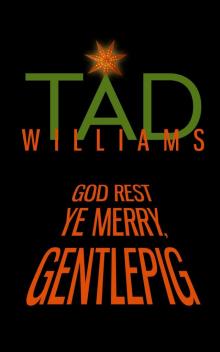 God Rest Ye Merry, Gentlepig
God Rest Ye Merry, Gentlepig Tailchaser's Song
Tailchaser's Song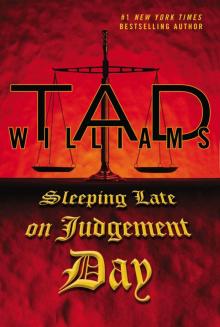 Sleeping Late on Judgement Day
Sleeping Late on Judgement Day Stone of Farewell
Stone of Farewell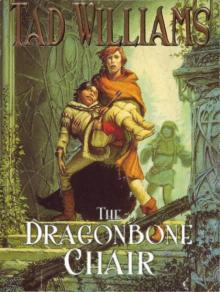 The Dragonbone Chair
The Dragonbone Chair Sea of Silver Light
Sea of Silver Light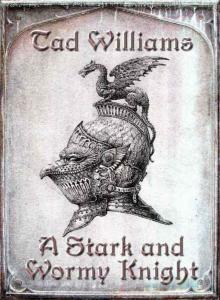 A Stark and Wormy Knight
A Stark and Wormy Knight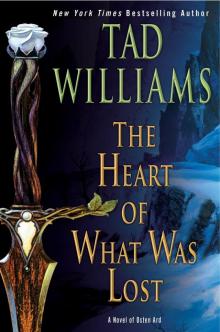 The Heart of What Was Lost
The Heart of What Was Lost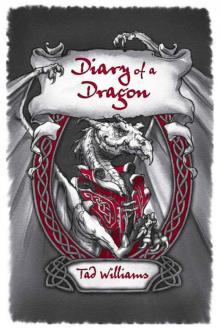 Diary of a Dragon
Diary of a Dragon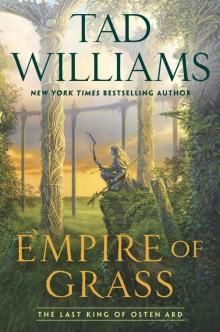 Last King of Osten Ard 02 - Empire of Grass
Last King of Osten Ard 02 - Empire of Grass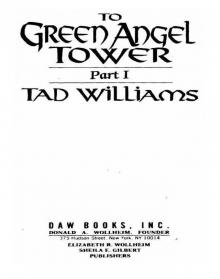 To Green Angel Tower, Volume 1
To Green Angel Tower, Volume 1 The Dirty Streets of Heaven
The Dirty Streets of Heaven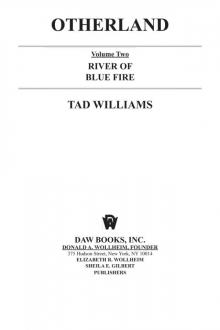 River of Blue Fire
River of Blue Fire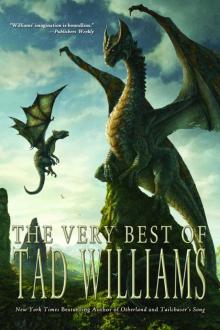 The Very Best of Tad Williams
The Very Best of Tad Williams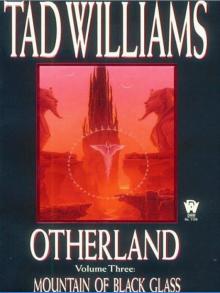 Mountain of Black Glass
Mountain of Black Glass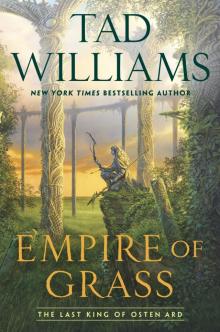 Empire of Grass
Empire of Grass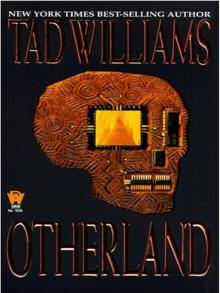 City of Golden Shadow
City of Golden Shadow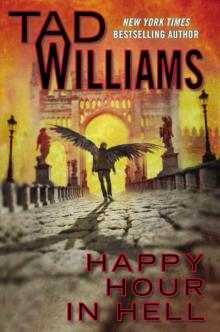 Happy Hour in Hell
Happy Hour in Hell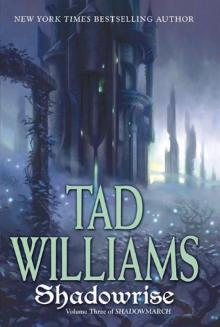 Shadowrise
Shadowrise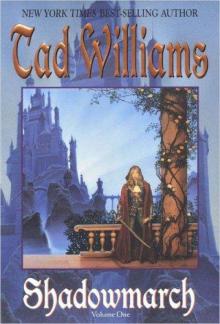 Shadowmarch
Shadowmarch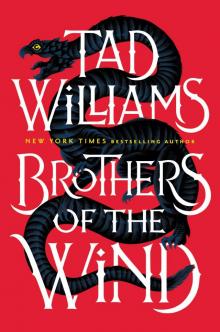 Brothers of the Wind
Brothers of the Wind Shadowheart
Shadowheart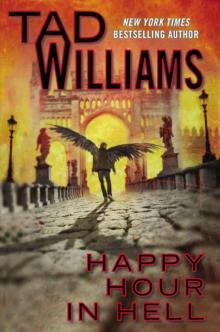 Bobby Dollar 02 - Happy Hour In Hell
Bobby Dollar 02 - Happy Hour In Hell The War of the Flowers
The War of the Flowers The Dirty Streets of Heaven bd-1
The Dirty Streets of Heaven bd-1 Tad Williams - The War of the Flowers (retail) (pdf)
Tad Williams - The War of the Flowers (retail) (pdf)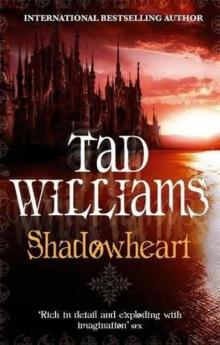 Shadowheart s-4
Shadowheart s-4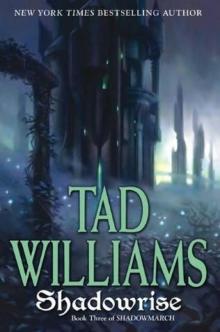 Shadowrise s-3
Shadowrise s-3 The Dirty Streets of Heaven: Volume One of Bobby Dollar
The Dirty Streets of Heaven: Volume One of Bobby Dollar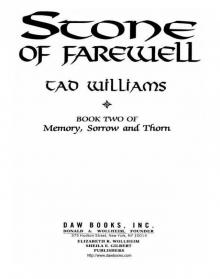 The Stone of Farewell
The Stone of Farewell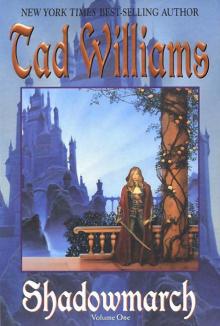 (Shadowmarch #1) Shadowmarch
(Shadowmarch #1) Shadowmarch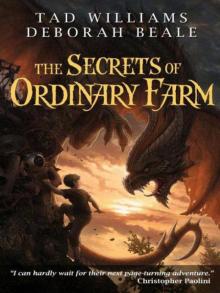 The Secrets of Ordinary Farm of-2
The Secrets of Ordinary Farm of-2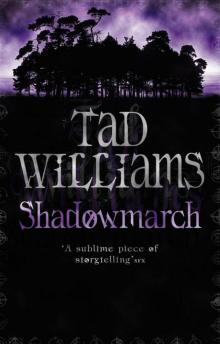 Shadowmarch s-1
Shadowmarch s-1![Bobby Dollar [04] God Rest Ye Merry, Gentlepig Read online](http://i1.bookreadfree.com/i1/04/06/bobby_dollar_04_god_rest_ye_merry_gentlepig_preview.jpg) Bobby Dollar [04] God Rest Ye Merry, Gentlepig
Bobby Dollar [04] God Rest Ye Merry, Gentlepig Lightspeed Issue 33
Lightspeed Issue 33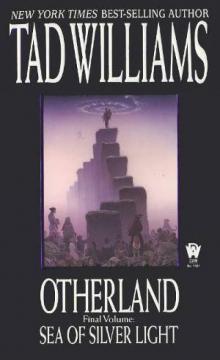 Sea of Silver Light o-4
Sea of Silver Light o-4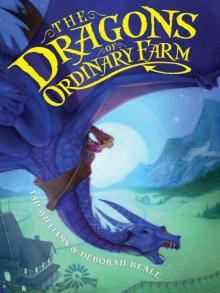 The Dragons of Ordinary Farm of-1
The Dragons of Ordinary Farm of-1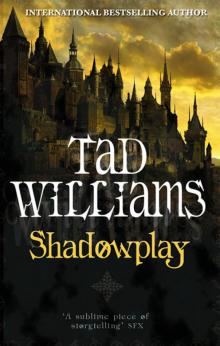 Shadowplay s-2
Shadowplay s-2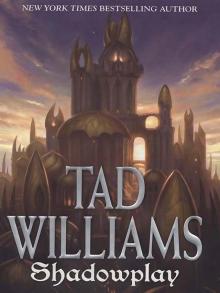 (Shadowmarch #2) Shadowplay
(Shadowmarch #2) Shadowplay